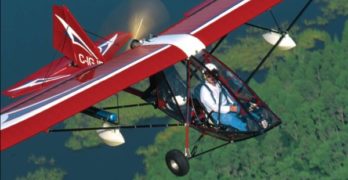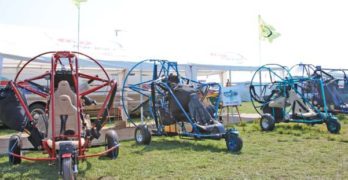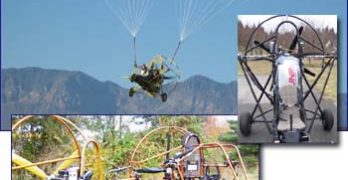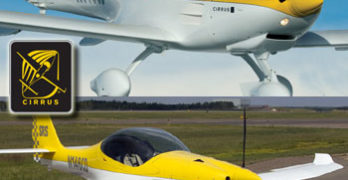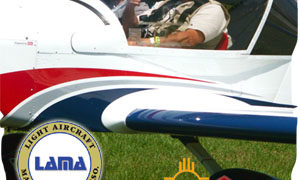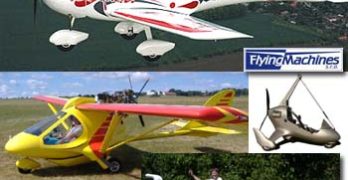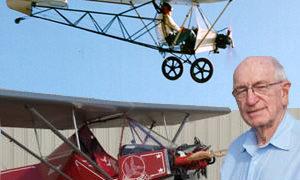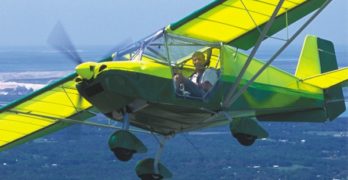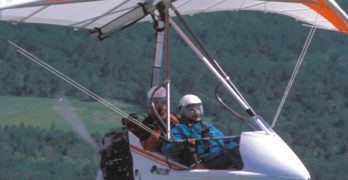The Beaver and Chinook ultralight-like aircraft are arguably two of the bestknown
lightweight designs coming from Canada. Aircraft Sales and Parts, more
commonly known as ASAP, is the company that rescued and now manufactures
and sells these designs, along with a powered parachute from its sister company,
Summit Powered Parachutes. The tale of ASAP’s involvement with the Chinook
and Beaver offers insight into ultralight progress – Canadian style.
A History Lesson
Perhaps the most famous ultralight
to come out of Canada is the Beaver.
With a reported 2,200 flying units
since the early 1980s, it’s a successful
design. However, due to corporate
missteps by the companies that
owned the brand, the Beaver series
was nearly lost. Originally, the Beaver
models were manufactured by
Spectrum Aircraft Inc. Reorganization
left the ultralight in the hands
of a company called Beaver RX Enterprises.
In 1993, that company closed
its doors and stranded thousands of
Beaver aircraft owners, along with
all the dealerships that sold and serviced
them.
Search Results for : Part 103
Not finding exactly what you expected? Try our advanced search option.
Select a manufacturer to go straight to all our content about that manufacturer.
Select an aircraft model to go straight to all our content about that model.
To Infinity…and Beyond!
The world of light-sport
aircraft (LSA) includes five
classes of aircraft-airplanes,
gliders, powered parachutes, weightshift-
control aircraft (commonly
called trikes), and lighter-than-air
aircraft (balloons and airships).
While fixed-wing airplanes may be
the most prolific, they are not the
only way for flight enthusiasts to
take to the sky. Weight-shift trikes
and powered parachutes (PPCs) are
also popular modes of flights. Each
offers a different experience to pilot
and passenger.
Some fixed-wing pilots claim
no interest in powered parachutes.
While PPCs certainly aren’t fast,
they do offer one of the best viewing
platforms in aviation and have
attracted a higher percentage of
non-pilots as buyers than any other
aviation segment. That fact alone
should cause more aviators to look
closely at them.
So far three powered parachute
companies have obtained special
LSA (S-LSA) approval for their
models. The first to achieve this
was the Summit 2 from Summit
Powered Parachutes in April 2006.
Hat Trick: 3 Six Chuter Powered Parachute SLSA
Six Chuter marketing man, Doug Maas, figures it’s like soccer where three goals in a game makes a “hat trick.” With their third model gaining SLSA airworthiness before the January 31 deadline for ultralight conversions, the Washington company has earned the sports phrase. The powered parachute (PPC) producer’s newest approvals brings the total to 75 SLSA models…in less than three years! *** Boss and designer Dan Bailey planned to create three models based on common airframes. Consequently, Six Chuter has the market covered like, uh…well, like a parachute canopy. They have a “conventional” tandem (Legend XL); a rare side-by-side PPC (XT SSDC), intended as a trainer appealing to instructors who want to be alongside their student; a single seat SLSA (P103); and a Part 103 qualifier (P103UL), when flown with the Rotax 503 and few accessories. The mainline PPC Legend was derived from Six Chuter’s SR7 and Spirit models but all were redone to fully address the Light-Sport Aircraft rule.
Cirrus SRS Orders + a dozen LSA & an Ultralight
SEBRING 2008 — Opening day started fast with press announcements from Cirrus — the GA company started taking orders for their SRS — and from Flight Design as the company unveiled their much-anticipated CTLS. But that was hardly all as the fourth Sebring Expo got going. I found a dozen newsworthy airplanes at the event and I may have missed some (I’ll keep searching). *** Gobosh introduced the 800XP, a sleek composite companion to the metal 700S. Sport Aircraft Works offered their just approved Dynamic LSA with fixed gear and prop. Skykits showed their shiny new Rampage with electric slots and Fowler flaps, and Urban Air USA showed their Lamabada LSA motorglider for the first time at a U.S. airshow. SportairUSA revealed their third generation Sting S3 with a new wing design and other updates.
LAMA & Sponsors Plan Big Gathering at Sebring 2008
Here comes Sebring 2008, Expo #4. Come see new airplanes — Flight Design’s CTLS, a composite Part 103 entry from Interplane, a new Tecnam model, plus other first appearances. Sebring is also business-to-business, for example, the Light Aircraft Manufacturers Association holding both a board of directors meeting and their annual member meeting. This year, LAMA’s gathering will be the largest ever. More than 300 people have RSVP’d to a generous offer from Sandia Aerospace who will provide a pig roast dinner after a short State-of-LSA presentation by LAMA president Tom Gunnarson and yours truly. EAA‘s Ron Wagner will give fresh information about LSA at AirVenture 2008. *** Located in the high desert of Albuquerque, New Mexico, Sandia Aerospace was founded in 1997 by a group of professionals to provide high quality avionics products to the aviation market.
LSA in Flight Schools; Allegro Reports Success
Fantasy Air USA and LSA America in central North Carolina sell three SLSA: Interplane SkyBoy, Fantasy Air Allegro 2007, and Flying Machines Mystique. They’ll soon also have the Part 103 ZJ Viera. *** In addition to distributing LSA nationally, Fantasy Air USA runs a profitable flight training operation. Proprietors Doug and Betty Hempstead report 33 students have completed training with an average of 28 hours to obtain their Sport Pilot certificate. Using the Allegro at $70/hour + $30 for a flight instructor, they’ve kept the cost below $3,000 — compared to $8,000 or more to get a Private license. Doug reports average burn of just 2.5 gph during instruction (training is flown slower than cruise speeds). Many students drive 1-4 hours to obtain training, though a map on the office wall shows a growing network of Allegros used in flight training.
Name Game Confusion Even Affects SPLOG
In my work for the LSA industry since its birth in the summer of 2004, a common lament I’ve heard is that we have “too many…” new aircraft names, company names, importer names. These statements were from people actively working with the industry so newcomers are surely confused. *** Although I believed I had good information, for some time in SPLOG postings and in articles I’ve written, I’ve called Mystique an airplane from Interplane, the folks who build Skyboy and more (see photos). But Flying Machines, another Czech company, is Mystique’s creator. Thanks to Pascal Nelson of Greensboro NC for catching the error. Other websites I’ve visited also have it wrong, and while I’m curious how that happened, it’s now corrected everywhere on ByDanJohnson.com. *** Flying Machines was formed in 2004 and builds two versions of the FM250, the Vampire (for Europe) and Mystique (for U.S.).
What High Prices? Legal Eagle Less Than $10,000!
With good reason — that is, prices soaring past $100,000 for the most deluxe LSA — lots of recreational pilots are griping that the SP/LSA rule has priced them out of the market. To many, it seems all the carbon fiber, glass cockpit LSA airplanes are going to pilots selling out of their Bonanzas and Cessna 182s.
Others lament, “You can’t buy a three axis Part 103 airplane that honestly stays within 103’s tight limits.” And most would probably agree that a Part 103 airplane with a four stroke engine is an impossibility. Well, that’s just plain wrong.
If a simple, single-seat airplane will satisfy your flying interests, you can build Texas designer Leonard Milholland‘s Legal Eagle using his Better Half VW engine for less than $10,000 according to several who report completions. Yes, you have to scrounge parts and do the work yourself. But a growing support group of other builders seems ready to help.
Sky Ranger Defines a New Niche
Listening to the aviation media drumbeat about Sport Pilot/Light-Sport Aircraft, you could be excused for thinking ultralights had “vanished” and that it now takes $55,000 to $95,000 to buy a light recreational aircraft. Fortunately, this just isn’t so.
We’re beginning to identify the emergence of a middle ground and the Sky Ranger is positioned in this space. According to my Sky Ranger check pilot Ryan Gross, our test plane could be supplied by Sky Ranger Aircraft Company for $40,000 in ready-to-fly form. While this is significantly more than the Sky Ranger 503 kit I flew four years ago, it is about half the cost of the average new 3-axis light-sport aircraft (LSA), though some models, like the Fantasy Air Allegro 2000, are only $15,000 more than the Sky Ranger.
Regardless of how the Sky Ranger Aircraft Company may elect to supply fully-built aircraft versus kits, the design of this airplane was optimized to be a quick and easily-built kit.
GT Ultralights: A Versatile Trike Supplier
Ukrainian airframe producer Aeros has risen from complete obscurity in the early 1990s (after the Berlin Wall fell) to wide recognition in recreational aviation. Although powered ultralight and light-sport aircraft enthusiasts may not immediately know the brand, hang glider pilots around the world are very aware of the name. The current reigning world champion hang glider pilot is Oleg Bondarchuck, a Ukrainian pilot who works with Aeros.
This young company emerging from the former Soviet mantel also makes an ultralight sailplane plus two powered aircraft. Aeros produces the Sky Ranger 3-axis airplane (under agreement with its French designer), and it has designed and markets its own trike. The company also supplies trike wings for other producers like Antares. By any normal measurements, Aeros is a versatile company.
Many ultralight and LSA pilots probably know the Aeros Velocity trike, and may recall its earlier name, Venture. In those days, it was sold by Sabre Aircraft alongside the trikes that Arizona company made here in America.
- « Previous Page
- 1
- …
- 30
- 31
- 32
- 33
- 34
- …
- 53
- Next Page »


